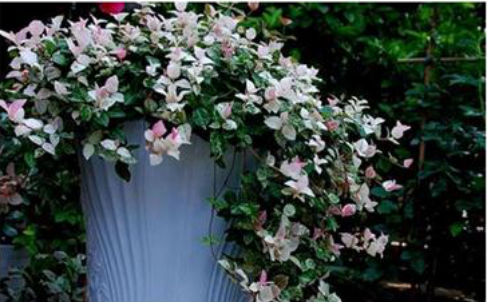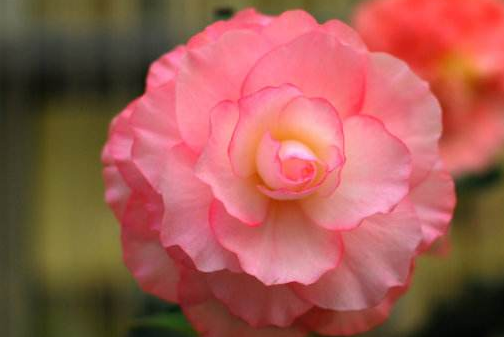How to cut the flower leaf collaterals?
1. Season selection.
Huaye Luoshi can be propagated by cutting all the year round, but the rooting rate and survival rate of cuttings in spring and autumn are the highest.
3. Insert the bed.
The cutting bed substrate can be mixed with vermiculite powder, peat soil and perlite at 2:5:3, and then put into the hole plate. If you directly use the nutrition bowl as the cutting substrate, you only need to add a portion of fine sand to the substrate. If the conditions do not permit, you can also directly use fine sand as a seedbed for cutting.
2. Cuttings selection and treatment.
Choose strong-growing vines and cut them into segments about ten centimeters long, leaving a bud point on each segment. After the cuttings are treated with rooting agent, the cuttings should be inserted into the cutter immediately and then watered thoroughly.
3. Plug-in management.
Always check the cutter after cutting, keep the cutter moist, the content is more than 50%, keep the temperature within 38 degrees, and spray water to cool down if the temperature is high. At the same time, shading treatment should be done from cuttage to rooting and sprouting to avoid direct sunlight. Cuttings usually take root in a week.

How to raise mosaic collaterals, mosaic collaterals cuttings, mosaic collaterals poisonous, mosaic collaterals florescence, mosaic collaterals price mosaic collaterals, evergreen woody vines, stems with indistinct lenticels. Branchlets, young petioles and leaves abaxially pubescent, old branches and leaves glabrous. It is a light-loving, strong shade-tolerant plant and likes the environment with high air humidity. it can be used as a perennial "flowering" plant for various flower mirror arrangements. at the same time, it is also an excellent potted plant material. How to raise the flower and leaf collaterals
Like light, slightly resistant to shade, like the environment with high air humidity, suitable for living in acidic and neutral soil with good drainage. Strong in sex, strong in disease resistance and exuberant in growth, similar to Chinese native collaterals. At the same time, it has strong drought resistance, short-term flood resistance and cold resistance. It can realize open-air cultivation in the south of the Yangtze River basin, and appropriate protective measures can be taken in order to survive the winter safely, such as increasing light, mainly applying nitrogen fertilizer to promote plant growth from March to August, applying appropriate amount of phosphorus and potassium fertilizer in September and early October to promote plant health, and forbidding pruning in October. Such as indoor potted plants, it can be used in any area, especially in areas with better light conditions.
Mosaic cuttings
Summer cuttings are easy to rot for some branches that are too young, but the branches that reach semi-Lignification can take root and survive. In addition, the lotus stone can also be striped and propagated, generally, the old branches are pressed in early spring, the twigs are pressed in summer, about 3cm is buried in the soil, and both nodes and internodes can take root into a new plant, but the propagation rate of striping propagation is not fast, and the amount of labor is large, so it is difficult to apply large-scale production.
The technique of tissue culture has been completed, and the corresponding tissue culture system has been established in our tissue culture room. Flowers and leaves can appear in the process of tissue culture, and the ornamental characters are stable. According to the double consideration of its growth and ornamental value, the cultivation of mosaic stone can properly distinguish between seedling production, plant cultivation and the cultivation of finished seedlings, that is, mass propagation and early plant cultivation under the most suitable environmental conditions, such as semi-sprouting, loose and fertile cultivation substrate, and when the plant reaches 20cm length and more branches, it is cultivated under strong light conditions, in order to achieve bright leaf color.
Is mosaic stone poisonous?
No, it is an evergreen woody vine with inconspicuous lenticels in its stem. Branchlets, young petioles and leaves abaxially pubescent, old branches and leaves glabrous. It is a light-loving, strong shade-tolerant plant and likes the environment with high air humidity. it can be used as a perennial "flowering" plant for various flower mirror arrangements. at the same time, it is also an excellent potted plant material.
Flowering stage of mosaic stone
The ornamental value of Huaye Luoshi is reflected in three levels of leaf color, that is, the color group composed of red leaves, pink leaves, pure white leaves, variegated leaves and green leaves, which is very similar to a cluster of flowers in full bloom, extremely gorgeous and colorful. Huaye Luoshi is in full bloom all the year round, but it is the best in spring, summer and autumn. In order to achieve the best color effect, intensity pruning is needed in spring to promote sprouting, increase ornamental branches and form compact clumps of plants.
Price of mosaic stone
Height: 25cm crown width 25cm reference price: 0.55 yuan per tree
Height: 20cm crown width 15cm reference price: 0.45RMB per tree
Height: 30cm crown width 20cm reference price: 0.4 yuan per tree
Height: 40cm crown width 20cm reference price: 0.35yuan per tree.
Related encyclopedia
Pocket scale non-woven bag lantern bamboo shoots crab feet red rice note3ykk zipper ybs zipper mountain cherry climbing wall plum field decision tomorrow winter plum green pine watch omega Longine watch children's building blocks rhododendron roll stick fruit Annona
The rooting rate of spring and autumn can reach more than 98%. Cutting in summer is easy to rot some branches that are too young, but the branches that are semi-lignified can take root and survive. In addition, the lotus stone can also be striped and propagated, generally, the old branches are pressed in early spring, the twigs are pressed in summer, about 3cm is buried in the soil, and both nodes and internodes can take root into a new plant, but the propagation rate of striping propagation is not fast, and the amount of labor is large, so it is difficult to apply large-scale production. The technique of rapid propagation of mosaic stone in tissue culture has been completed, and the corresponding tissue culture system has been established in our tissue culture room (see another article). Flowers and leaves can appear in the process of tissue culture, and the ornamental character is stable. According to the double consideration of its growth and ornamental value, the cultivation of mosaic stone can properly distinguish between seedling production, plant cultivation and the cultivation of finished seedlings, that is, mass propagation and early plant cultivation under the most suitable environmental conditions, such as semi-sprouting, loose and fertile cultivation substrate, and when the plant reaches 20cm length and more branches, it is cultivated under strong light conditions, in order to achieve bright leaf color.
- Prev

Can hydroponic culture of mosaic collaterals take root?
1. Hydroponic culture of branches. The mosaic stone usually grows and propagates in the soil, but it can also be propagated by hydroponic rooting because of the air root in its node stem. When hydroponic culture, the mosaic collaterals of adult plants should be selected, and the branches with roots on the stems should be cut.
- Next

Matters needing attention in the Culture of Begonia bulbosa
There are mainly three kinds of propagation of Begonia bulbosa: sowing propagation, cutting propagation and cutting tuber propagation. Sowing and reproduction can choose spring sowing or autumn sowing. Cutting propagation is mainly suitable in late spring and early summer. The main pests of Begonia bulb are thrips, aphids and leaf rollers.
Related
- Fuxing push coffee new agricultural production and marketing class: lack of small-scale processing plants
- Jujube rice field leisure farm deep ploughing Yilan for five years to create a space for organic food and play
- Nongyu Farm-A trial of organic papaya for brave women with advanced technology
- Four points for attention in the prevention and control of diseases and insect pests of edible fungi
- How to add nutrient solution to Edible Fungi
- Is there any good way to control edible fungus mites?
- Open Inoculation Technology of Edible Fungi
- Is there any clever way to use fertilizer for edible fungus in winter?
- What agents are used to kill the pathogens of edible fungi in the mushroom shed?
- Rapid drying of Edible Fungi

